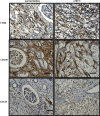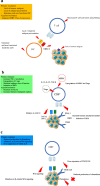Determinants of resistance to VEGF-TKI and immune checkpoint inhibitors in metastatic renal cell carcinoma
- PMID: 34099013
- PMCID: PMC8183071
- DOI: 10.1186/s13046-021-01961-3
Determinants of resistance to VEGF-TKI and immune checkpoint inhibitors in metastatic renal cell carcinoma
Abstract
Vascular endothelial growth factor tyrosine kinase inhibitors (VEGF-TKIs) have been the mainstay of treatment for patients with advanced renal cell carcinoma (RCC). Despite its early promising results in decreasing or delaying the progression of RCC in patients, VEGF-TKIs have provided modest benefits in terms of disease-free progression, as 70% of the patients who initially respond to the treatment later develop drug resistance, with 30% of the patients innately resistant to VEGF-TKIs. In the past decade, several molecular and genetic mechanisms of VEGF-TKI resistance have been reported. One of the mechanisms of VEGF-TKIs is inhibition of the classical angiogenesis pathway. However, recent studies have shown the restoration of an alternative angiogenesis pathway in modulating resistance. Further, in the last 5 years, immune checkpoint inhibitors (ICIs) have revolutionized RCC treatment. Although some patients exhibit potent responses, a non-negligible number of patients are innately resistant or develop resistance within a few months to ICI therapy. Hence, an understanding of the mechanisms of VEGF-TKI and ICI resistance will help in formulating useful knowledge about developing effective treatment strategies for patients with advanced RCC. In this article, we review recent findings on the emerging understanding of RCC pathology, VEGF-TKI and ICI resistance mechanisms, and potential avenues to overcome these resistance mechanisms through rationally designed combination therapies.
Keywords: Clear cell renal carcinoma; Epithelial mesenchymal transition; Hypoxia; Metastatic renal cell carcinoma; Sunitinib; Vascular endothelial growth factor, tyrosine kinase inhibitor.
Conflict of interest statement
The authors declare no competing interests.
Figures






Similar articles
-
Significance of tumor microenvironment in acquiring resistance to vascular endothelial growth factor-tyrosine kinase inhibitor and recent advance of systemic treatment of clear cell renal cell carcinoma.Pathol Int. 2020 Oct;70(10):712-723. doi: 10.1111/pin.12984. Epub 2020 Jul 11. Pathol Int. 2020. PMID: 32652869 Review.
-
The Association Between PD-L1 Expression and the Clinical Outcomes to Vascular Endothelial Growth Factor-Targeted Therapy in Patients With Metastatic Clear Cell Renal Cell Carcinoma.Oncologist. 2015 Nov;20(11):1253-60. doi: 10.1634/theoncologist.2015-0151. Epub 2015 Sep 30. Oncologist. 2015. PMID: 26424759 Free PMC article.
-
Circulating cytokines associated with clinical response to systemic therapy in metastatic renal cell carcinoma.J Immunother Cancer. 2021 Mar;9(3):e002009. doi: 10.1136/jitc-2020-002009. J Immunother Cancer. 2021. PMID: 33688021 Free PMC article.
-
Safety and clinical activity of vascular endothelial growth factor receptor (VEGFR)-tyrosine kinase inhibitors after programmed cell death 1 inhibitor treatment in patients with metastatic clear cell renal cell carcinoma.Ann Oncol. 2016 Jul;27(7):1304-11. doi: 10.1093/annonc/mdw160. Epub 2016 Apr 7. Ann Oncol. 2016. PMID: 27059553 Free PMC article.
-
Molecular mechanisms of resistance to tyrosine kinase inhibitor in clear cell renal cell carcinoma.Int J Urol. 2022 Dec;29(12):1419-1428. doi: 10.1111/iju.15042. Epub 2022 Sep 19. Int J Urol. 2022. PMID: 36122306 Free PMC article. Review.
Cited by
-
Cancer marker TNFRSF1A: From single‑cell heterogeneity of renal cell carcinoma to functional validation.Oncol Lett. 2024 Jul 5;28(3):425. doi: 10.3892/ol.2024.14559. eCollection 2024 Sep. Oncol Lett. 2024. PMID: 39021735 Free PMC article.
-
Decoding sunitinib resistance in ccRCC: Metabolic-reprogramming-induced ABAT and GABAergic system shifts.iScience. 2024 Jun 28;27(7):110415. doi: 10.1016/j.isci.2024.110415. eCollection 2024 Jul 19. iScience. 2024. PMID: 39100925 Free PMC article.
-
Identification of IL20RB as a Novel Prognostic and Therapeutic Biomarker in Clear Cell Renal Cell Carcinoma.Dis Markers. 2022 Mar 8;2022:9443407. doi: 10.1155/2022/9443407. eCollection 2022. Dis Markers. 2022. PMID: 35299868 Free PMC article.
-
Trends and hotspots in targeted therapy resistance research for renal cell carcinoma: a bibliometric and visualization analysis.Discov Oncol. 2025 Jun 11;16(1):1055. doi: 10.1007/s12672-025-02772-0. Discov Oncol. 2025. PMID: 40498158 Free PMC article.
-
Renal Cell Carcinoma as a Metabolic Disease: An Update on Main Pathways, Potential Biomarkers, and Therapeutic Targets.Int J Mol Sci. 2022 Nov 18;23(22):14360. doi: 10.3390/ijms232214360. Int J Mol Sci. 2022. PMID: 36430837 Free PMC article. Review.
References
Publication types
MeSH terms
Substances
LinkOut - more resources
Full Text Sources
Miscellaneous

